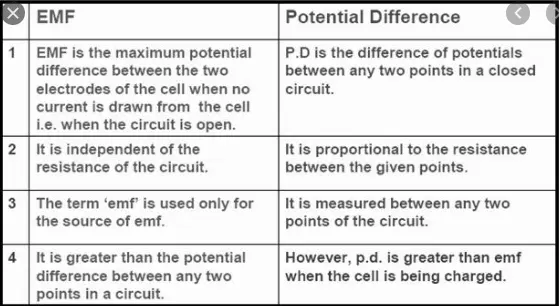What is the Difference Between emf and Potential Difference?


The emf (electromotive force) is the potential difference between the terminals of a battery when no current is flowing through an external circuit when the circuit is open. The potential difference is the voltage across the terminals of the battery when the current is being drawn from it to an external.
Now!
We learn in detail about electromotive force (emf) and potential difference (pd).
If you want to learn the difference between emf and potential difference then you are in the right place. So, keep reading for a few minutes.
What is Electromotive force?
The electromotive force E of the source is the energy supplied to the unit charge by the cell.
When a source of electrical energy is connected across a resistance R, it maintains a steady current through the resistance. The battery makes the positive charge flow in the external circuit.
Suppose a charge Δq passed through the circuit in time Δt. This charge enters the cell at its lower potential (negative terminal) and leaves at its positive end ( positive terminal), then the source must do work ΔW on the charge Δq in taking it to the positive terminal which is at the higher potential.
Thus, the emf of the source is defined as” the energy supplied to unit charge by the cell.”
E = Energy/unit charge
or
E = ΔW/Δq
The above relation is the electromotive force formula.SI unit of emf is Joule/Coulomb which is equal to volt.
What is Potential Difference in physics?
The potential difference across the two points of a conductor causes the dissipation of electrical energy into other forms of energy as charges flow through the circuit.
When one end A of a conductor is connected to the positive terminal and its other end B is connected to the negative terminal of the battery, then the potential at A becomes higher than the potential at B.
This causes a potential difference between the two points of the conductor. The flow of current continues as long as there is a potential difference. The agency which provides the potential difference for the steady flow of current in the copper wire is the battery. As the current flows from the higher potential to the lower potential through the conductor, the electrical energy (due to the current) is converted into other forms (heat and light, etc.).When current flows through the conductor, it experiences resistance in the conductor by collisions with an atom of the conductor. This energy supplied by the battery is utilized in overcoming this resistance and is dissipated as heat and other forms of energy. The dissipation of this energy is accounted for by the potential difference across the two ends of the light bulb.
Difference between electromotive force and potential difference
| Electromotive force (emf) | Potential Difference (Pd) |
| E.m.f is the energy supplied to the unit charge by the cell. | Potential difference is the energy dissipated as the unit charge passes through the components. |
| E.m.f is the cause. | Potential difference is the effect. |
| The emf is also present even when no current is drawn through the battery. | Potential difference across the conductor is zero in the absence of current. |
| Its unit is volt. | Its unit is volt. |
| It remains constant. | It does not remain constant. |
| It is always greater than a potential difference. | It is always less than emf. |
| It transmits current both inside and outside of the cell. | Potential difference transfer current between two points in the cell. |
| Its symbol is E. | Its symbol is V. |
| Its formula is E = I (Rtr) Rtr = total external and internal resistance. | Its formula is V = E – Ir |
| It does not depend on circuit resistance. | It directly depends on the resistance between two points of measurement. |
| It causes in electric, magnetic, and gravitational fields. | It induces only in the electric field. |
Emf Vs Potential difference (video)
Related topics
- Difference between electric potential and electric potential energy
- Difference between electric potential and potential difference
External references
- http://www.differencebetween.net/science/difference-between-electromotive-force-emf-and-potential-difference/
Related Post
Recent Posts
Is energy quantized in classical physics?
No, according to classical wave theory the emission of electromagnetic radiations from the surface is…
Types of laser
Basically, there are four types of laser which includes: Gas Lasers Solid State lasers Liquid…
Ultrasound frequency range
What is ultrasonics? The study and application of mechanical vibrations with frequencies beyond the limits…
Electromagnetic Energy: What are some examples of it?
Electromagnetic energy definition Electromagnetic energy is the amount of energy stored in a region of…
Fundamental units and Derived Units with Examples
The Main Difference between fundamental Units and Base units is that Units that Express base…
Newton’s First law of Motion Examples in Our Daily Life
Newton's first law of motion states that " A body continues its state of rest…
View Comments
nice of you creator i can die now because of your faut . you failed me in exam why why did'nt you can write easier way of another of electrical subject why why?????????????????????